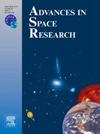Doppler velocity estimation based on the random sample consensus considering a prior dynamic model
IF 2.8
3区 地球科学
Q2 ASTRONOMY & ASTROPHYSICS
引用次数: 0
Abstract
Typically, centimeters per second (cm/s) accuracy can be achieved for velocity estimation based on time-differenced positioning, Doppler velocity, and the time-differenced carrier phase approach in open air conditions. However, velocity estimation performance can deteriorate due to non-line-of-sight (NLOS) signals, multipath effects, and other sources of interference in urban areas. We discuss a velocity estimation method based on the RANdom SAmple Consensus (RANSAC) algorithm and a prior dynamic model is proposed. RANSAC is used to isolate the observations affected by NLOS or multipath, while a prior dynamic model is implemented to provide proper velocity constraint. Vehicle kinematic experiments conducted in both open and complex urban environments demonstrate that the velocity accuracy in all three directions can be improved by over 40 % and centimeter-level velocity accuracy can be obtained in open areas. Moreover, the accuracy can be improved by 78.5 %, 78.5 %, and 68.4 % in the north, east, and up directions compared to that obtained by traditional single-point Doppler velocity, and 10.5 cm/s, 11.0 cm/s, and 14.3 cm/s accuracies are achieved in complex urban areas. Moreover, this method is also reasonably applicable to low-cost receivers.
求助全文
约1分钟内获得全文
求助全文
来源期刊

Advances in Space Research
地学天文-地球科学综合
CiteScore
5.20
自引率
11.50%
发文量
800
审稿时长
5.8 months
期刊介绍:
The COSPAR publication Advances in Space Research (ASR) is an open journal covering all areas of space research including: space studies of the Earth''s surface, meteorology, climate, the Earth-Moon system, planets and small bodies of the solar system, upper atmospheres, ionospheres and magnetospheres of the Earth and planets including reference atmospheres, space plasmas in the solar system, astrophysics from space, materials sciences in space, fundamental physics in space, space debris, space weather, Earth observations of space phenomena, etc.
NB: Please note that manuscripts related to life sciences as related to space are no more accepted for submission to Advances in Space Research. Such manuscripts should now be submitted to the new COSPAR Journal Life Sciences in Space Research (LSSR).
All submissions are reviewed by two scientists in the field. COSPAR is an interdisciplinary scientific organization concerned with the progress of space research on an international scale. Operating under the rules of ICSU, COSPAR ignores political considerations and considers all questions solely from the scientific viewpoint.
 求助内容:
求助内容: 应助结果提醒方式:
应助结果提醒方式:


